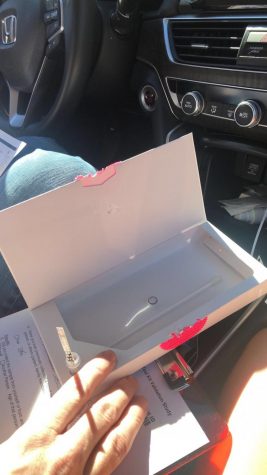Over the Counter COVID-19 Tests Enter Clinical Trials
April 20, 2021
Last year COVID-19 shut the world down, but now, as establishments reopen and schools return to in-person learning, there has been a surge in cases and many people have, at some point, had to get a COVID-19 test. So far we’ve been introduced to two types of COVID-19 tests; the rapid test and the Polymerase Chain Reaction (PCR) test. In 2021 however, we may see the introduction of a new type of test: the over-the-counter COVID-19 test.
If you have been tested recently, you most likely had to call ahead and make a curbside appointment, which required you to pull into a parking lot and have a nurse meet you at your window to swab your nose. Depending on what test you requested, you learned whether you tested positive or negative in 30 minutes (with the rapid test) or a couple days (with the PCR test).
I had to make an appointment to get both a rapid test and a PCR test after the girls on the Madison cheer team and I found out that someone on the team had tested positive for COVID-19. We shut down practice for the compulsory two weeks and settled in for a two-week self-quarantine. I had COVID-19 symptoms taking my status of “exposure” to “probable case.” The Fairfax County Health Department contacted me and my parents and let us know that by the end of the week, preferably as soon as possible I would have to get tested. We made an appointment and signed up to take both the PCR and rapid test curbside at Vienna Advanced Pediatrics.
I got there and called in to let them know that I was waiting in the parking lot. They answered and said that they would send out a nurse who would swab me twice. However, because I am 16, they let me know that I was eligible to take part in a clinical trial that was being run out of Vienna Advanced Pediatrics. A clinical trial is defined as “a research study in which one or more human subjects are prospectively assigned to one or more interventions to evaluate the effects of those interventions on health-related biomedical or behavioral outcomes,” according to the National Institute of Health grants and funding website.

I agreed to participate in the trial and they told me that I would be getting swabbed four times that day instead of just the two. The nurse brought a clipboard, a stack of files and a small cardboard box. She swabbed me twice for my rapid and PCR tests, then swabbed me a third time for the trial. She then explained that the clinical trial was for the over-the-counter COVID-19 test that they hoped to introduce to pharmacies soon. She told us that the test would be entirely conducted by myself, on myself and that it would take upwards of 30 minutes to complete.
Inside the box for the trial run were two paper-wrapped swabs, a small beaker of blue liquid, a test strip and a packet of directions. The first thing I had to do was swab myself, which was significantly less uncomfortable then having it swabbed by someone else. Then I had to swirl the swab around in the liquid three times and let it sit for 10 minutes. After the 10 minutes was up, I unwrapped the test strip and put it in the beaker where it had to sit for at least 15 minutes. After the 15 minutes was up, a single blue line appeared on the strip, meaning that my test had come back negative (One blue stripe means negative, a blue stripe and a red stripe means positive and a single red stripe means that it was a faulty test). My rapid test came back negative too.
Over the counter testing is a big step in testing for COVID-19 because people will not need to schedule an appointment or leave the comfort of their own homes for testing. It will also help to limit the spread of the virus. It is a simple and easy way to get quick results, however just like the current rapid tests, the results will not always be 100% accurate. If possible, always get a PCR test because the outcome will be more accurate. Although, in an urgent situation or a quick test, over-the-counter COVID-19 tests will hopefully prove to be very useful.
I was very excited to take part in the clinical trial because I was one of the first people to try it. In my experience it worked really well and I received an accurate reading that was quick and very easy. One of the highlights of the trial for me was that I was able to swab myself, I would compare it to being tickled, you can’t tickle yourself but someone else can. Comparatively swabbing yourself is much more comfortable and easy than being swabbed by someone else. This was the first clinical trial I have ever taken part in and I find that for the most part I enjoyed the experience.


